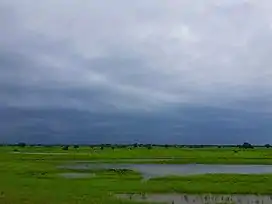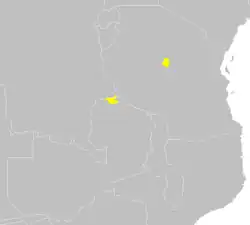| Itigi-Sumbu thicket | |
|---|---|
 | |
 Location of the Itigi-Sumbu thicket ecoregion | |
| Ecology | |
| Realm | Afrotropical |
| Biome | tropical and subtropical grasslands, savannas, and shrublands |
| Borders | |
| Geography | |
| Area | 10,997 km2 (4,246 sq mi) |
| Countries | |
| Coordinates | 5°33′S 34°27′E / 5.55°S 34.45°E |
| Conservation | |
| Conservation status | Critical/endangered[1] |
| Protected | 3,797 km2 (1,466 sq mi) (35%)[2] |
The Itigi-Sumbu thicket is an ecoregion consisting of two small areas of thick shrubland in Tanzania, Zambia and the adjacent Democratic Republic of the Congo, in East Africa. The floral community of dense deciduous brush is unique, with many endemic species, and almost no transition zone between it and the surrounding dry miombo woodlands. The distinctive nature of this small region is partly due to its setting on dry alluvial soil over a hard duricrust, while the surrounding areas are rocky hills and plateaus.[1][3][4][5]
Location and description
The thickets are found in the flatland between Lake Mweru Wantipa and Lake Tanganyika in Zambia (between 950 and 1,200 m (3,120 and 3,940 ft) above sea level), and near the town of Itigi in the Itigi District of Tanzania. The climate consists of a cool dry season from May to August, a hot dry season from August to November, and a rainy season from November to April.[1]
Climate
The climate of the ecoregion is hot semi-arid (Köppen climate classification (BSh)). This climate is characteristic of steppes, with hot summers and cool or mild winters, and minimal precipitation. The dry season (May to October) averages 20–27 °C (68–81 °F), and the wet season rising above 30 °C (86 °F).[6][7] The rainy season is November to April. Rainfall differs in the two different sites of this ecoregion, averaging 1,400 mm (55 in) per year in the Zambian site, but less than 500 mm (20 in) per year in the Tanzanian site.[1]
Flora
The extremely dense, impenetrable Itigi deciduous thicket is a unique mixture of over 100 species of woody shrubs 3 to 5 metres (9.8 to 16.4 ft) high. Characteristics species are two species of Baphia (Baphia burttii and Baphia massaiensis), Bussea massaiensis, Burttia prunoides, Combretum celastroides (a type of bushwillow), Grewia burttii, Pseudoprosopsis fischeri, and Tapiphyllum floribundum.
Fauna
Traditionally a habitat of elephant and black rhino, the area is vulnerable to poaching and rhinos have been eradicated from the area. The thickets are also home to three endemic reptiles – the Urungu beaked snake (Rhinotyphlops gracilis), four-fingered skink (Sepsina tetradactyla), and Johnston's long-tailed lizard (Latastia johnstonii).
Threats and preservation
The thickets are being extensively cleared for firewood and for cultivation as the populations of the two countries grow, with 50% gone in Tanzania (which is unprotected) and 70% in Zambia, which does have some protection in the Mweru Wantipa National Park. The largest blocks of thicket remain on the northern shores of Lake Mweru Wantipa and in the eastern portion of the Zambian Itigi thicket.
A 2017 assessment found that 3,797 km2 (1,466 sq mi), or 35%, of the ecoregion is in protected areas.[2] Protected areas include:
- Mweru Wantipa National Park,
- Nsumbu National Park, and
- Kaputa Game Management Area in Zambia.
References
- 1 2 3 4 "Itigi-Sumbu thicket". World Wildlife Federation. Retrieved July 3, 2021.
- 1 2 Eric Dinerstein, David Olson, et al. (2017). An Ecoregion-Based Approach to Protecting Half the Terrestrial Realm, BioScience, Volume 67, Issue 6, June 2017, Pages 534–545; Supplemental material 2 table S1b.
- ↑ "Map of Ecoregions 2017". Resolve, using WWF data. Retrieved June 20, 2021.
- ↑ "Itigi-Sumbu thicket". Digital Observatory for Protected Areas. Retrieved June 20, 2021.
- ↑ "Itigi-Sumbu thicket". The Encyclopedia of Earth. Retrieved June 20, 2021.
- ↑ Kottek, M., J. Grieser, C. Beck, B. Rudolf, and F. Rubel, 2006. "World Map of Koppen-Geiger Climate Classification Updated" (PDF). Gebrüder Borntraeger 2006. Retrieved September 14, 2019.
{{cite web}}: CS1 maint: multiple names: authors list (link) CS1 maint: numeric names: authors list (link) - ↑ "Dataset - Koppen climate classifications". World Bank. Retrieved September 14, 2019.